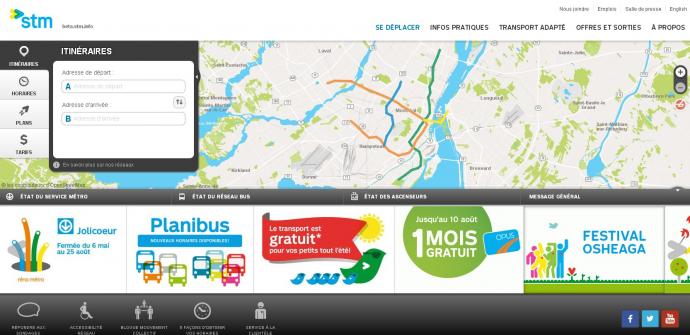This Wednesday, the STM will publicly unveil its new website. Meeting the needs expressed by users in public consultations with cutting-edge web technology, the new site offers even more intuitive navigation and meets the highest standards for universal accessibility.
This Wednesday, the STM will publicly unveil its new website. Meeting the needs expressed by users in public consultations with cutting-edge web technology, the new site offers even more intuitive navigation and meets the highest standards for universal accessibility. It will be deployed gradually in versions suitable for laptops (both PC and Mac) and tablets, and in a mobile version for all smartphones. Subsequently, the old site will be completely phased out in favour of the new site.
Developed by the TP1 agency in partnership with Adviso, the new STM website has been designed according to the needs of public transit users: it focuses on trip planning and offers more and easier-to-find content, within a new look in accordance with the STM’s brand image. This is the first complete redevelopment of the STM’s website since it first went on line in 1997.
The Scrum agile software development methodology was used throughout the project, and all software used by TP1 to create the site is open-source. Specifically, the site was developed on the Drupal and Ruby on Rails platforms, each of which is strengthened by contributions from a large community of software developers. The mapping system uses Open Street Map. In addition, the site was developed according to the principle of adaptive design (i.e. optimized for the full range of web plaforms: smartphones, tablets, laptops, desktops, etc.).
"The entire project was developed using agile methodology, with a multi-disciplinary team of UX designers, programmers and other specialists, who worked in close collaboration with the STM (the client even had the keys to our office!). The agile approach enabled us to quickly deliver a high-quality and innovative product. I am particularly proud of the itinerary planning tool and the mobile version, which offer a unique experience designed for users on the go" said Jan-Nicolas Vanderveken, partner at TP1.
Universal accessibility: compliance with WCAG 2.0 AA standard
The STM’s new website meets the Web Content Accessibility Guidelines (WCAG) 2.0 AA standard. Very few companies anywhere in the world successfully meet “double A” standards.
The WCAG 2.0 standard consists of a broad range of recommendations for making websites more accessible to people with disabilities, including blindness and low vision, colourblindness, deafness and hearing loss, learning disabilities, cognitive limitations, limited movement, and photosensitivity.
For example, the site allows users to adjust colour contrasts, increase font size by up to 200%, and navigate using the keyboard or voice control; in addition, content is organized in a uniform fashion to accommodate users with cognitive limitations.
In reaching the WCAG 2.0 AA accessibility standard, the STM consulted extensively with the organization Accessibilité Web. In addition to providing its expertise in the area, the organization performed regular audits and consultations with people with disabilities and community representatives over the course of the site’s development.
